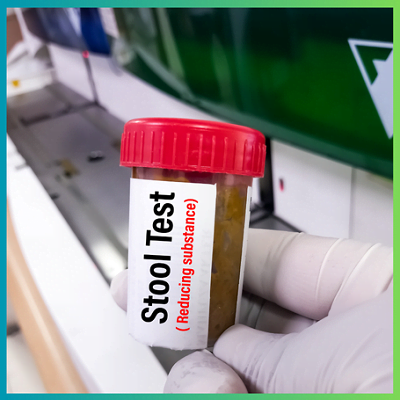
A stool routine examination test is an analysis of a stool sample to detect various substances or organisms that may indicate digestive or metabolic conditions.

This test examines the physical, chemical, and microscopic properties of the stool to check for infections, digestive disorders, or nutrient absorption problems.
How is the Stool Routine Examination Test Conducted?The process of a stool routine examination test is simple and non-invasive. Here's how it is typically conducted:
1] Sample Collection: The patient is provided with a sterile container to collect a stool sample. It's important that the sample does not come into contact with water, urine, or other contaminants to ensure accurate results.
2] Laboratory Analysis: Once the sample is collected, it is sent to the lab for analysis. The stool sample is examined under a microscope and tested for physical, chemical, and microscopic components.
3] Results: The results usually come back within 24 to 48 hours, depending on the laboratory. These results provide insight into various factors, including the presence of blood, parasites, fat, bacteria, or other indicators of disease.
The normal range for a stool routine test is based on the physical, chemical, and microscopic components of the stool. Here's a breakdown of what a healthy stool sample looks like in various categories:
1] Color: Brown (normal), yellowish (normal in infants)
2] Consistency: Formed, soft, or semi-solid
3] Blood: Absence of visible or occult (hidden) blood
4] Mucus: None or trace amounts
5] pH: 6.5 to 7.5
6] Fat: Should not be present in large amounts (small amounts are normal)
7] Parasites: None present
8] WBCs (White blood cells): None present
9] Ova and cysts: Should be absent
At Diagnopein, we offer comprehensive, accurate, and timely diagnostic services, including the stool routine examination test Pune. With our NABL-accredited labs, cutting-edge technology, and skilled technicians, you can be assured of reliable results every time. Get your results quickly, especially when time is crucial in detecting severe infections.
Competitive pricing without compromising on quality. Our team of experienced professionals ensures the test is conducted smoothly with minimal discomfort. We provide not just the stool routine examination test results but insights into your health condition, helping you and your doctor make informed decisions about treatment. For more information call us at +91 9204 108108.
1. Color
2. Consistency
3. Reaction (pH)
4. Mucous
5. Blood
6. Pus Cells
7. Epithelial Cells
8. Red Blood Cells (RBCs)
9. Ova
10. Cysts
11. Starch granules
12. Vegetable cells
13. Fat Globules
14. Occult Blood
15. Fixed fecal smear
16. Others
Yes, certain foods can affect stool color, consistency, and pH. It’s important to inform your healthcare provider about your diet before taking the test, especially if you consume large amounts of certain foods like beets (which can affect stool color).
No, the stool routine test is a completely non-invasive and painless procedure since it only involves collecting a stool sample.
While a stool routine examination test provides valuable information, it may not detect all gastrointestinal conditions, particularly those that require more invasive diagnostic methods like a colonoscopy. It is often a preliminary test used to guide further testing.
A stool routine test is performed to identify gastrointestinal conditions, infections, malabsorption syndromes, inflammation, and bleeding within the digestive tract. It is commonly recommended for symptoms like diarrhea, constipation, abdominal pain, blood in the stool, or unexplained weight loss.